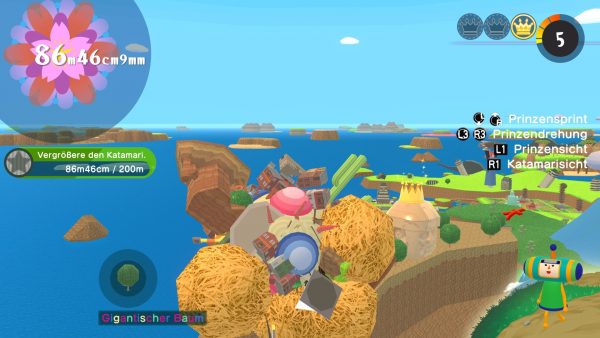Switch to: German
In Once Upon A Katamari, the Prince is sent to different eras to save the universe, but does the signature Katamari gameplay stand the test of time?
Once Upon A Katamari is the seventh mainline game in the series, which began with Katamari Damacy on PlayStation 2 in 2004. Most recently, a mobile spin-off, Katamari Damacy Rolling LIVE, was released in April of this year, along with remasters of the first two entries Katamari Damacy REROLL (2018) and We ♥ Katamari REROLL+ Royal Reverie (2023). The last mainline game in the series, Touch My Katamari for the PlayStation Vita, was released 13 years ago.
Once Upon A Katamari, released on October 24th on Steam for PC, Nintendo Switch, PlayStation 5, and Xbox Series X|S, is the debut game from the Osaka-based studio RENGAME, whose name is a combination of the lotus flower Renge and the word game. The King of the Cosmos has accidentally destroyed the Earth and the stars while playing with his magical scroll. Our task is to travel through different eras and fill the hole in the scroll with as many rolled-up Katamaris as possible. Katamaris are sticky balls collecting anything in their way. We move on to travel through ten worlds with over 50 levels, which take us to, among other places, the Jurassic, Ice, and Stone Ages, the Edo period, and the Wild West. The imaginative worlds are particularly evident in the levels themselves, while the overworld areas are somewhat sparsely designed.
RENGAME successfully utilizes the tried-and-tested Katamari formula: From fruit and animals to entire marketplaces, skyscrapers, and islands – nothing is safe from the Katamari we’re rolling. However, we still need to exercise some caution, as individual objects can fall off if we bounce off obstacles that are currently too large. To move the ball, we can either use the classic twin-stick controls or opt for the simplified one-stick control scheme. While newcomers will find the simplified controls slightly easier to pick up, they offer far less precise control of the ball compared to the standard controls, which require some getting used to. To roll the ball forward, we push both analog sticks forward and to rotate it, we move both sticks in opposite directions. Pressing both sticks simultaneously allows us to do a U-turn, and the shoulder buttons let us sprint briefly. Depending on momentum and timing, rotating the ball can be either quick or agonizingly slow. Since we’re supposed to collect as many objects as possible in a limited time, this can initially lead to some frustration. Similarly, the King’s comments, which appear in the center of the screen, are more distracting than helpful amidst the already overwhelming sensory overload, even though they occasionally contain useful tips about the locations of hidden objects in the level. An option to display these messages more subtly would certainly be helpful. After a few hours of gameplay, however, you get a grip of the unusual control scheme and also for how large the Katamari needs to be to collect objects without annoyingly bouncing off them.
The main levels feature a range of objectives. We usually have to reach a certain size within a specific time limit or collect certain objects like food or money. The creative levels are the real stars of Once Upon A Katamari. The game takes us to an ancient Greek palace where we have to collect a certain number of roses. In the hot springs, we roll past bathing bears and cows, crush troublemakers and voyeurs, and in an ancient theater, we disrupt a classical concert, only to hand over the collected flowers to a wedding couple at the end. We’d better not tell the assembled guests that we’ve already collected their iconic philosophers and launched them into space. On a pirate ship, we face a giant sea monster. In more open levels, we can even explore entire islands, starting by rolling up pebbles and eventually progressing to massive skyscrapers. Once we reach a certain size, we can progress to a new area which feels natural in the more open levels. However, some layouts are repeated a little too often, such as when we collect the interior of a house and are only then allowed outside to finally collect the coveted crowns; by then, the strict time limit is often already far advanced. While a certain number of crowns are always required to progress, we don’t have to replay older levels in order to progress like in many other games. Power-ups include rockets for a short-term speed boost and a magnet that automatically attracts surrounding objects.
In competitive levels, we compete either online against other players or against the artificial intelligence (AI). Since the servers were relatively empty during our testing period, we faced the AI. They actually perform quite well, and the races to reach a certain size or a predetermined goal are quite challenging. In each level, we can collect high scores and up to three crowns, as well as find a gift and hidden cousins of the Prince. This provides long-term engagement beyond the campaign, which can be completed in seven to eight hours. Furthermore, due to their short length, the levels can be played repeatedly, for example, on a PC handheld or on the Switch. We can freely switch between the different cousins in the overworld and customize their appearance rudimentary.
While Once Upon A Katamari is compelling in terms of gameplay, the story is more of a means to an end. The narrative is primarily told through short, creative to bizarre speeches from the King and brief video sequences, the image quality of which is quite low. The German translation largely captures the spirit of the franchise, but it does contain some spelling and logical errors. The voice acting is only available in English, although there is hardly any spoken dialogue in the game anyway. The slapstick humor in the cutscenes is comparable to the LEGO games from TT Games.
Audiovisually, Once Upon A Katamari is a treat. The colorful visuals, the stylish effects, and the low-poly art style all come together beautifully. While the game isn’t outstanding on a technical level, its presentation is incredibly charming. This includes the fantastic, energetic soundtrack, which further fuels the wild action on screen. The occasional piano ballad and the odd jazz song round off the experience. We tested the game on PC, and the hardware requirements aren’t too demanding. A GeForce RTX 4070 is often underutilized, even at 4K resolution and 160 FPS with the highest graphics settings.
Final thoughts
Once Upon A Katamari is a great action-puzzle game with a charming presentation and varied level design. While the title is a good entry point into the series, there is still a barrier due to the odd controls. The Katamari concept still works well today. After getting used to the controls and the sensory overload, you’ll be looking forward to the next chapter, which will most likely celebrate Japanese culture in all its facets in a creative way. The time travel aspect provides visual variety, and the different objectives offer some gameplay variation. The campaign is quite short at seven to eight hours, but that’s still several hours longer than some other entries in the series. The hunt for additional crowns and gifts also provides extra playtime, which you’ll happily spend with Once Upon A Katamari, though it will likely not change the minds of those who haven’t been into Katamari’s signature gameplay. We’re eager to see what setting the next installment in the series will take us to and how long we’ll have to wait for it this time.
Bandai Namco provided us with a PC copy of Once Upon A Katamari, which we used to capture the screenshots.










